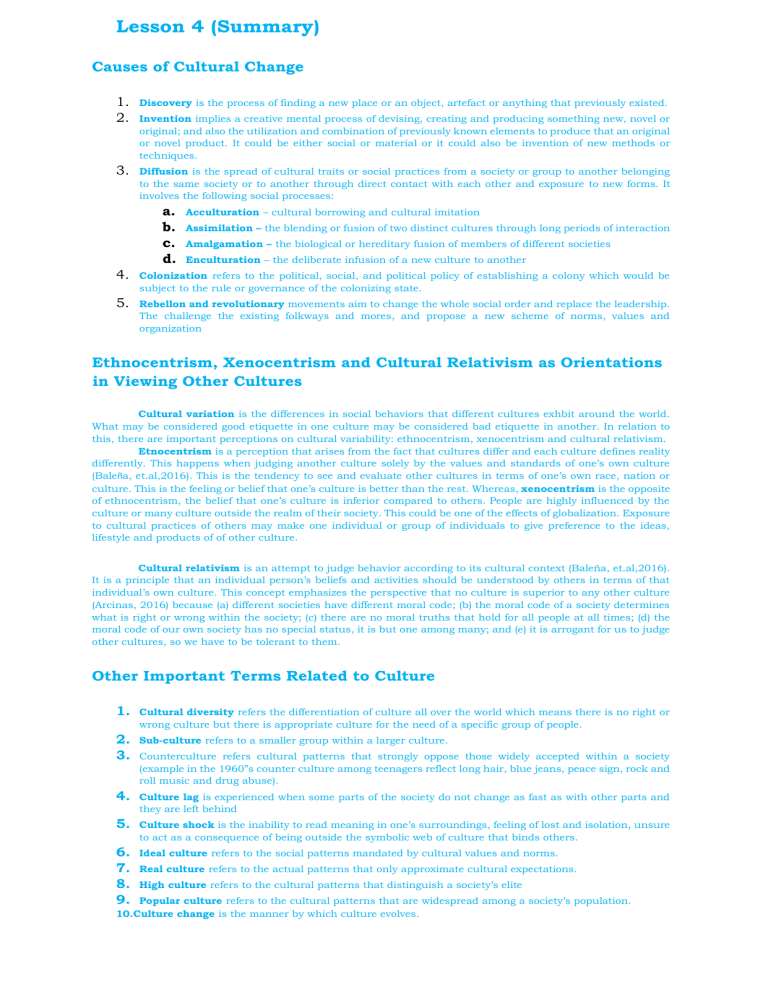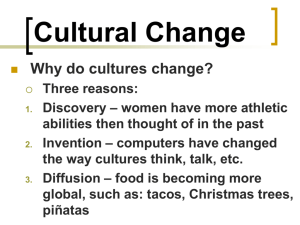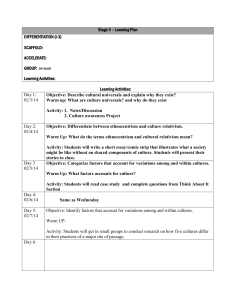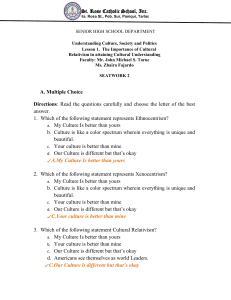
Lesson 4 (Summary) Causes of Cultural Change 1. 2. Discovery is the process of finding a new place or an object, artefact or anything that previously existed. 3. Diffusion is the spread of cultural traits or social practices from a society or group to another belonging to the same society or to another through direct contact with each other and exposure to new forms. It involves the following social processes: Invention implies a creative mental process of devising, creating and producing something new, novel or original; and also the utilization and combination of previously known elements to produce that an original or novel product. It could be either social or material or it could also be invention of new methods or techniques. a. b. c. d. Acculturation – cultural borrowing and cultural imitation Assimilation – the blending or fusion of two distinct cultures through long periods of interaction Amalgamation – the biological or hereditary fusion of members of different societies Enculturation – the deliberate infusion of a new culture to another 4. Colonization refers to the political, social, and political policy of establishing a colony which would be subject to the rule or governance of the colonizing state. 5. Rebellon and revolutionary movements aim to change the whole social order and replace the leadership. The challenge the existing folkways and mores, and propose a new scheme of norms, values and organization Ethnocentrism, Xenocentrism and Cultural Relativism as Orientations in Viewing Other Cultures Cultural variation is the differences in social behaviors that different cultures exhbit around the world. What may be considered good etiquette in one culture may be considered bad etiquette in another. In relation to this, there are important perceptions on cultural variability: ethnocentrism, xenocentrism and cultural relativism. Etnocentrism is a perception that arises from the fact that cultures differ and each culture defines reality differently. This happens when judging another culture solely by the values and standards of one’s own culture (Baleña, et.al,2016). This is the tendency to see and evaluate other cultures in terms of one’s own race, nation or culture. This is the feeling or belief that one’s culture is better than the rest. Whereas, xenocentrism is the opposite of ethnocentrism, the belief that one’s culture is inferior compared to others. People are highly influenced by the culture or many culture outside the realm of their society. This could be one of the effects of globalization. Exposure to cultural practices of others may make one individual or group of individuals to give preference to the ideas, lifestyle and products of of other culture. Cultural relativism is an attempt to judge behavior according to its cultural context (Baleña, et.al,2016). It is a principle that an individual person’s beliefs and activities should be understood by others in terms of that individual’s own culture. This concept emphasizes the perspective that no culture is superior to any other culture (Arcinas, 2016) because (a) different societies have different moral code; (b) the moral code of a society determines what is right or wrong within the society; (c) there are no moral truths that hold for all people at all times; (d) the moral code of our own society has no special status, it is but one among many; and (e) it is arrogant for us to judge other cultures, so we have to be tolerant to them. Other Important Terms Related to Culture 1. Cultural diversity refers the differentiation of culture all over the world which means there is no right or wrong culture but there is appropriate culture for the need of a specific group of people. 2. 3. Sub-culture refers to a smaller group within a larger culture. 4. Culture lag is experienced when some parts of the society do not change as fast as with other parts and they are left behind 5. Culture shock is the inability to read meaning in one’s surroundings, feeling of lost and isolation, unsure to act as a consequence of being outside the symbolic web of culture that binds others. 6. 7. 8. 9. Ideal culture refers to the social patterns mandated by cultural values and norms. Counterculture refers cultural patterns that strongly oppose those widely accepted within a society (example in the 1960”s counter culture among teenagers reflect long hair, blue jeans, peace sign, rock and roll music and drug abuse). Real culture refers to the actual patterns that only approximate cultural expectations. High culture refers to the cultural patterns that distinguish a society’s elite Popular culture refers to the cultural patterns that are widespread among a society’s population. 10.Culture change is the manner by which culture evolves.





![EDUC_1300_Final_Exam_Review[1].doc](http://s2.studylib.net/store/data/015309055_1-905c844c2c8b94d6429e5d22bf38d4de-300x300.png)
